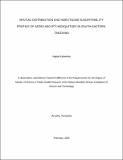| dc.description.abstract | Aedes-borne diseases such as dengue and chikungunya constitute constant threats globally. In
Tanzania, the main vector species is Aedes aegypti, which is widely distributed in urban areas, but
whose ecology remains poorly-understood in growing towns and secondary cities. We collected
adult mosquitoes using Gravid Aedes trap and surveyed aquatic habitats of Ae. aegypti mosquitoes
in and around Ifakara, a fast-growing town in south-eastern Tanzania. Field-collected mosquitoes
were tested for susceptibility to common insecticides in dry and rainy seasons. A total of 926
mosquitoes were collected, 431 (46.5%) were identified as Aedes aegypti, 487 (52.5%) Culex, 8
(0.01%) as other Aedes and 13 (0.01%) as Anopheles mosquitoes. Of 1515 and 1933 aquatic
habitats examined in dry and rainy seasons respectively, 18.87% and 14.64% contained Aedes
immatures (container index. In the 2315 and 2832 houses visited in dry and rainy seasons, 4.9%
and 6.6% had at least one Aedes-positive habitat. The main habitat types included: (a) used vehicle
tires and discarded containers, (b) flower pots and clay pots, and (c) holes made by residents on
trunks of coconut trees to support climbing harvesters. Aedes aegypti adults were susceptible to all
tested insecticides in both seasons, except bendiocarb, against which resistance was observed in
rainy season. The high infestation levels indicate significant risk of Aedes-borne diseases,
requiring immediate action to prevent potential outbreaks in the area. While used tires, discarded
containers and flower pots are key habitats for Aedes, this study also identified coconut harvesting
as an important risk factor, and the associated tree-holes as potential targets for Aedes control.
Since Ae. aegypti mosquitoes are still susceptible to insecticides, effective control could combine
environmental management, preferably involving communities, habitat removal and insecticide
spraying. | en_US |


